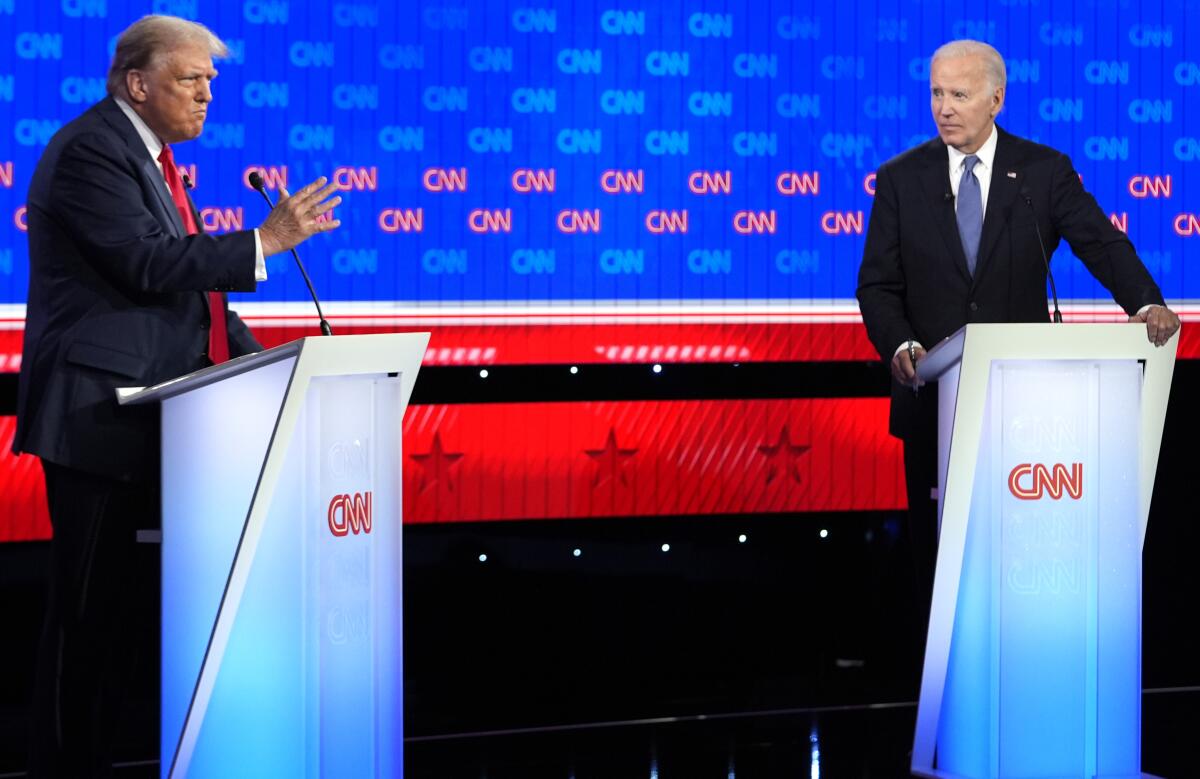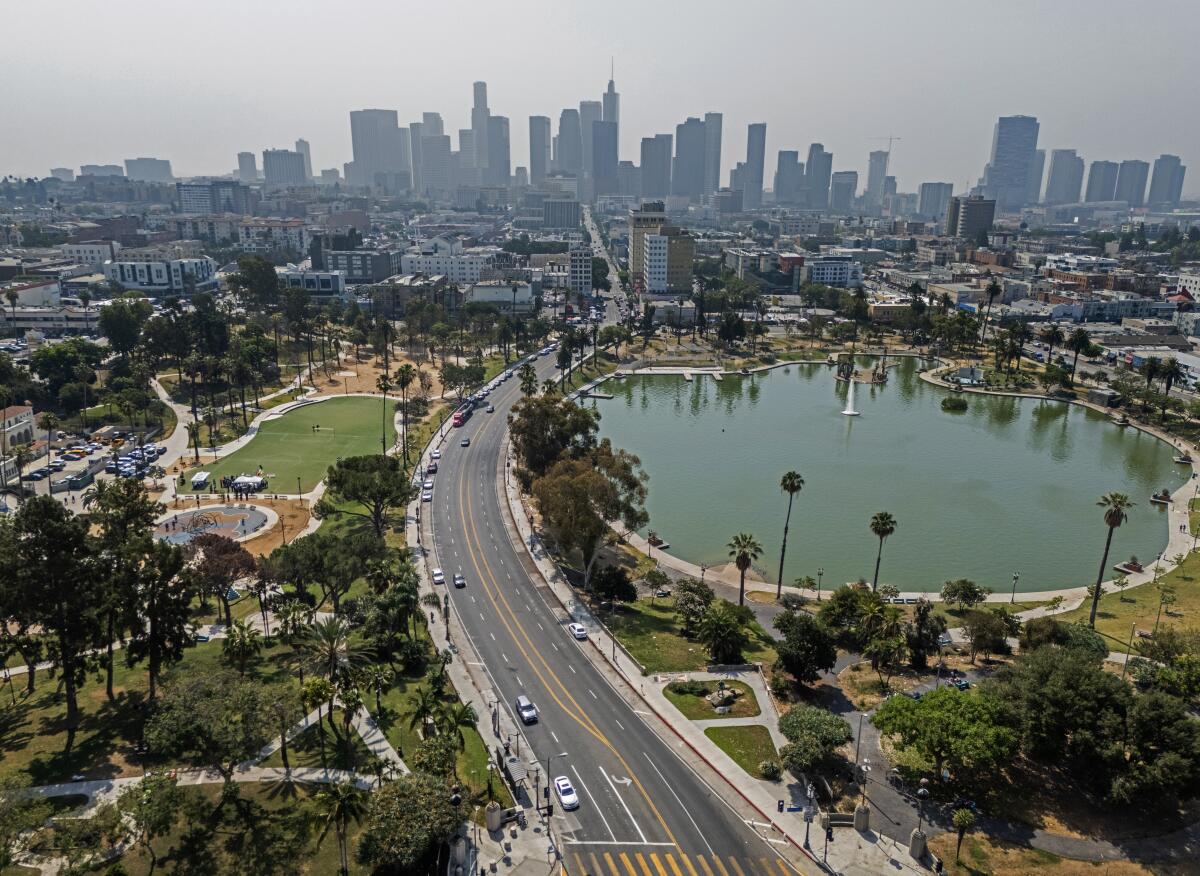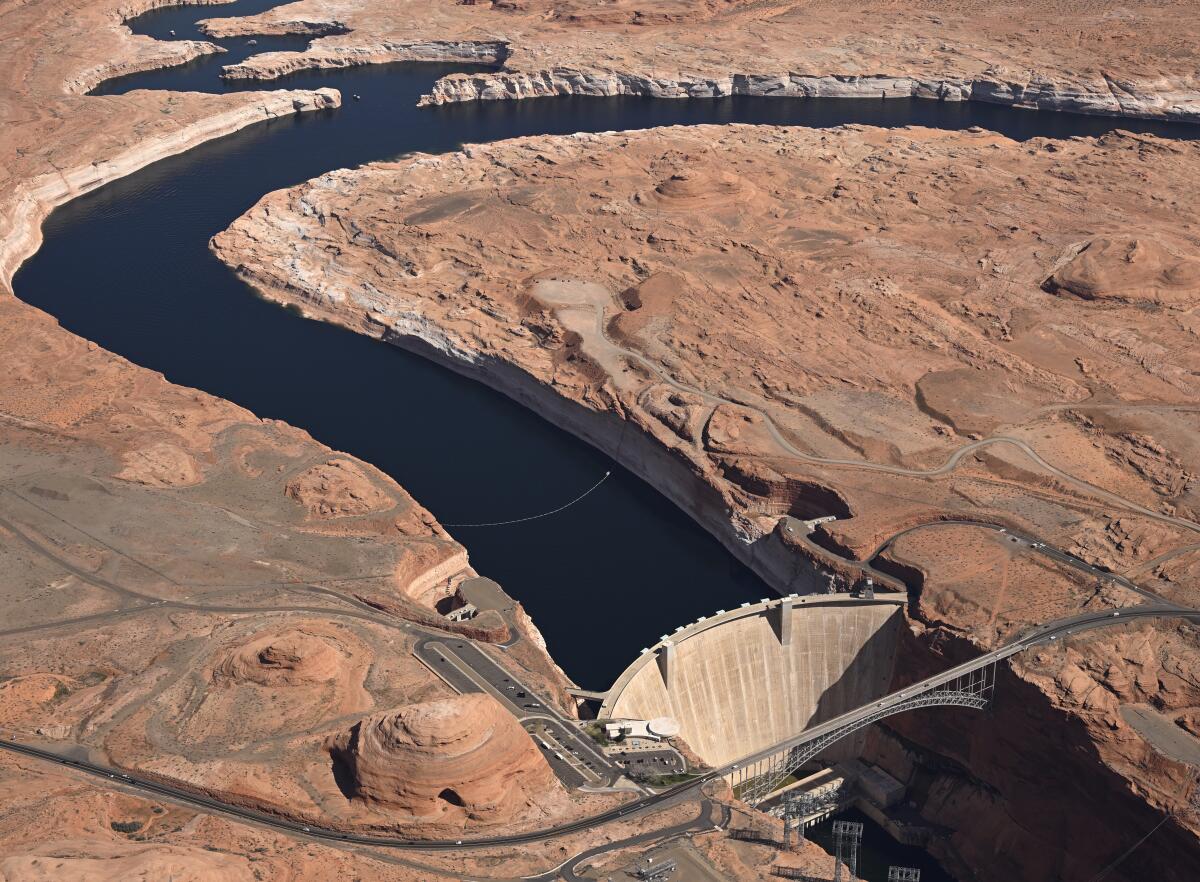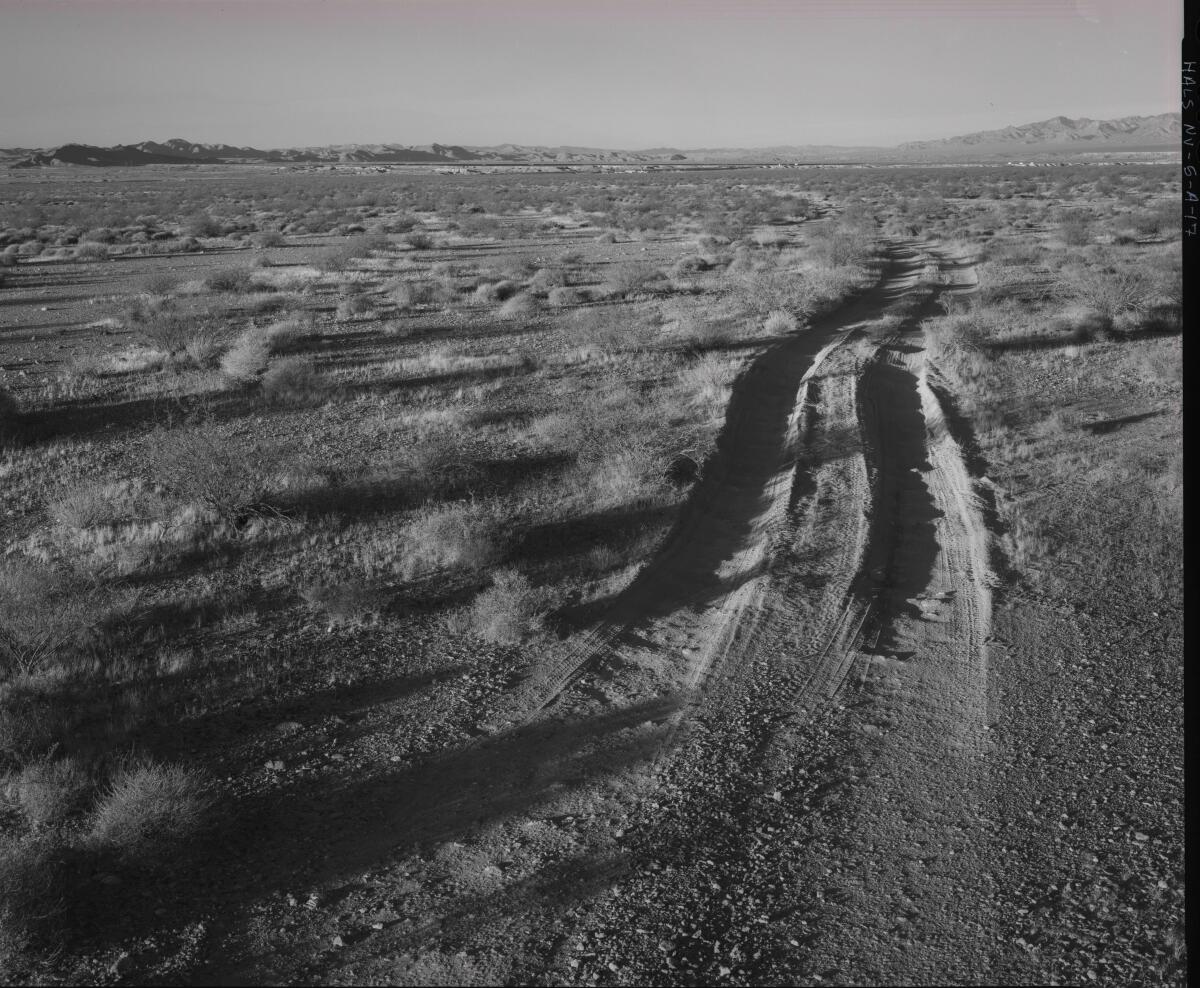Boiling Point: Why Los Angeles can’t afford to go third on clean energy

- Share via
“Utilities race to be second. And sometimes it’s better to be third.”
So said Fred Pickel, the Los Angeles Department of Water and Power’s in-house ratepayer advocate, at a DWP board meeting in December 2019, a few months before the pandemic brought everyday life to a screeching halt. He was discussing the city’s first-of-its-kind plan to convert a coal plant to green hydrogen — a key piece of L.A.’s plans to reach 100% clean energy by 2035.
Pickel was intrigued. But he was also concerned that the coal-to-hydrogen conversion would be expensive, driving up electric bills for DWP customers. He suggested that maybe the city should back off, and wait for some other public or private utility to invest in the innovative technology and drive down costs. Then Angelenos could take advantage of the cheap clean energy later on.
“Be mindful of the consequences,” Pickel said. “Be mindful of the tradeoffs.”
You're reading Boiling Point
Sammy Roth gets you up to speed on climate change, energy and the environment. Sign up to get it in your inbox twice a week.
You may occasionally receive promotional content from the Los Angeles Times.
Five years later, he’s singing the same song.
As my L.A. Times colleague Dakota Smith reports, Pickel now recommends that the city delay its 100% clean energy goal beyond the 2035 target established by former Mayor Eric Garcetti and supported by current Mayor Karen Bass, and endorsed by the City Council. According to a report commissioned by Pickel’s office, monthly bills could rise by 7.7% annually if DWP sticks to the 2035 timeline. Pushing the target back to 2045 — the date mandated by state law — could lead to bill increases of just 4.8%.
“We shouldn’t blindly charge ahead for 2035 come hell or high water,” Pickel said.
The problem is, if we don’t charge toward 2035, the result will be both hell and high water.
The most dangerous consequences of climate change are yet to come — and to quote former Vice President Al Gore, the global weather report recently has been like “a nature hike through the Book of Revelation.” The American West is broiling, with record-shattering heat and 20 times more land burned in California than this time last year despite a similar number of fires. We’ve seen lethal heat in India, deadly floods in China and catastrophic storms in Chile, as The Times’ Max Kim and Stephanie Yang report.
Here are a few heat stories that might melt your brain:
- Extreme heat brings all sorts of nasty side effects you might not expect, including higher rates of homicide, suicide, preterm births and deaths from heart disease, as well as lower test scores in schools. (Story by Emily Alpert Reyes, L.A. Times)
- Even before climate change, Death Valley National Park’s extreme heat was, as the name suggests, deadly. Weirdly, tourists love visiting for exactly that reason. Here’s how park staff do their best to keep people alive. (Noah Haggerty, L.A. Times)
- Add this to the “yikes” department: Rising temperatures are making it harder for helicopters to rescue people suffering from heat illness on hot days in national parks, because the air is too thin for copters to take off. (Kylie Mohr, the Atlantic)
The wildfire situation is pretty bleak, too:
- How are firefighters handling more extreme temperatures? One may have just died from heat in Oregon. In California, crews fighting one blaze just built generator-powered, air-conditioned yurts to cool down. (Alex Wigglesworth, L.A. Times)
- Prison inmates, by the way, are uniquely exposed to heat. They’ve got nowhere to go, and some say California is doing a poor job of keeping them safe in aging, overcrowded facilities, many of which don’t have central A/C. (Hayley Smith, L.A. Times)
- As wildfire risks worsen, California has fewer inmate firefighters than ever. What’s going on? (Ruben Vives, L.A. Times)
And lest we forget that heat storms and infernos carry serious economic costs:
- Seven heat waves alone created $7.7 billion in health, safety and economic costs in California in the last decade, a report from the state’s Department of Insurance found — and that is far from a complete accounting. (Caelyn Pender, Mercury News)
- Climate-fueled wildfires are among the factors prompting Allstate and State Farm to seek major home insurance rate hikes in California, although critics say the firms are asking for too much. (Laurence Darmiento and Andrea Chang, L.A. Times)
- Clearing plants and mulch from around your home isn’t free either. But California fire officials are writing rules that would ban combustible materials within 5 feet of homes in fire-prone parts of the state. (Julie Johnson, San Francisco Chronicle)
Los Angeles can’t solve the climate crisis on its own. We need global action.
But as I noted last month in a column on DWP’s new chief executive, Los Angeles is America’s second-largest city, not to mention a global trendsetter through its entertainment, technology and cultural prowess. The city’s commitment to 100% clean energy by 2035 — which lines up with what scientists say is necessary to avoid the worst harms of global warming — could embolden other states and nations. Likewise, backing away from the 2035 commitment could be uniquely devastating.
Is it even possible for Pickel to include those kinds of variables in his calculations?
Curious, I called up the ratepayer advocate, who is retiring later this year. He emphasized that he understands the high costs of the climate crisis and wants to see aggressive action. But he thinks Los Angeles could get more bang for its buck by going most of the way to 100% clean electricity by 2035 and then dedicating its dollars to other climate solutions, such as electric vehicles.
It’s important to avoid exorbitant utility bill hikes not only because low- and middle-income Angelenos can’t afford them, but also because other states and nations won’t follow our lead on renewable energy if the price tag is too high, Pickel told me.
“Five percent above inflation?” he asked, skeptical. “Who do they think they are, higher education? Or healthcare?”
After a decade reporting on the energy transition, this is one of several dilemmas to which I keep returning.
The financial case for phasing out heat-trapping fossil fuels is awesome, especially once you account for their human health and economic costs. Increasingly affordable solar panels, wind turbines and batteries have only made the case more attractive.
But replacing our fossil fuel infrastructure comes with up-front costs. Replacing it fast enough to keep temperatures to less-than-dystopian levels — a time crunch brought to us by decades of Big Oil climate denial campaigns — only adds to the costs.
Someone needs to go first. Someone needs to be willing to pay a little more, come hell or high water.
I asked Pickel: Why not Los Angeles?
His answer: “I’m a ratepayer advocate.”
As he should be. But L.A. still needs to lead, and that means 100% clean energy by 2035. We can’t afford to cross our fingers and hope someone else goes first. Climate isn’t the only thing that matters. But if we don’t get it right, nothing else matters.
On that note, here’s what else I’m following:
NATIONAL POLITICS

We’re less than four months from the presidential election, and no, I don’t have any idea what’s going to happen.
I can tell you with certainty, though, that if former President Trump returns to the White House, he’ll continue his first-term efforts to eviscerate protections for climate, clean air and human health. During last month’s debate, he told a bunch of lies about his track record, as I chronicled for The Times. This week, he chose as his running mate Ohio Sen. J.D. Vance, who has become a climate denier and renewable energy hater as he’s angled for Trump’s support, per the New York Times’ Lisa Friedman.
In one of Vance’s more ludicrous statements, he once asked about environmentalists, if “they think climate change is caused by carbon emissions, then why is their solution to scream about it at the top of their lungs, send a ton of our jobs to China, and then manufacture these ridiculous ugly windmills all over Ohio farms that don’t produce enough electricity to run a cellphone on?”
Can President Biden defeat Trump? Again, I have no clue. But the number of people and organizations urging Biden to step aside is growing. The youth-led Sunrise Movement joined the list this week, with the climate advocacy group’s executive director saying that the president “isn’t positioned to mobilize young people and win in November,” as NYT’s Lisa Friedman reports.
Even before last month’s poor debate performance, Biden already wasn’t super popular among young climate voters, despite his having signed the Inflation Reduction Act, the biggest climate law in U.S. history, and taken many other steps to slash emissions, such as pausing approval of gas export terminals (a move that was just blocked by a Trump-appointed judge). Biden has at times hurt his cause by taking ill-advised actions such as approving oil and gas projects on public lands.
But on climate (and basically every other issue), there’s a stark difference between Biden and Trump. The same would be true of any other Democratic nominee. The Sunrise Movement says it will campaign hard against Trump no matter what.
A few more national stories:
- Meet some of the first Californians serving in Biden’s American Climate Corps, inspired by FDR’s Civilian Conservation Corps. They include a rooftop solar installer, a compost communicator and a Wildfire Ready Raccoon. (Noah Haggerty, L.A. Times)
- The Biden administration is giving $2 billion in grants to car manufacturers and auto parts companies to help them convert factories to electric vehicle production. Most of the money will go to swing states. (Russ Mitchell, L.A. Times)
- Former U.S. Sen. Jim Inhofe, who brought a snowball to the Senate floor to try to prove that climate change isn’t real, died at 89. He called global warming “the greatest hoax ever perpetrated on the American people.” (Ken Miller, Associated Press)
CALIFORNIA CLIMATE

Here in the Golden State, climate progress continues to advance — some of the time.
In a potentially big win for green space and climate-friendly transit, L.A. is considering closing a short stretch of Wilshire Boulevard through MacArthur Park to cars. My colleague Rachel Uranga has details. She also profiled biking advocate Michael Schneider, describing him as “brash, privileged and unapologetic about forcing Los Angeles to build more bike lanes.”
In other good news, The Times’ Colleen Shalby reported that California’s high-speed train is now totally cleared for construction, environmentally speaking, from L.A. to San Francisco. Colleen also had an update on LAX’s long-awaited People Mover train.
Big Oil certainly isn’t giving up the fight — but it is dropping a November ballot measure that would have let companies drill new wells within 3,200 feet of California homes, schools and hospitals. Here’s the story from my colleague Tony Briscoe, who writes that even after spending more than $25 million on the campaign, the industry realized it was probably going to lose.
Gov. Gavin Newsom fought hard to defeat the ballot measure. But in other instances he’s been less aggressive on climate.
One of the latest instances: His administration wants to delay a landmark corporate emissions disclosure law by two years, after previously proposing to gut funding for the law’s implementation, before backing off, as Politico’s Jordan Wolman reports.
Several other issues where climate advocates are frustrated with the governor and his appointees:
- Newsom’s administration chose not to require two of the state’s largest oil drillers, which just merged, to set aside money to plug low-producing oil wells, which activists say should have been required under existing law. Capital & Main’s Aaron Cantú reported on the issue before the merger was completed. Politico covered the administration’s final decision (scroll down).
- Rooftop solar installers and environmental justice groups are suing an obscure state agency over a new rule that could block hundreds of solar companies from installing home batteries. They see the rule as the Newsom administration’s latest attempt to do the bidding of utilities and labor unions that prefer large solar farms to rooftop solar. (Jeff St. John, Canary Media)
- The state’s first-ever “climate information system” has fallen victim to deficit-driven budget cuts. (Hayley Smith, L.A. Times)
At the statehouse, meanwhile, Assemblymember Eduardo Garcia tried and failed to amend the California Environmental Quality Act to make it easier to build transmission lines to send renewable energy to cities. Environmental groups opposed the bill, worried that poorly placed transmission towers would damage state parks, as Ryan Sabalow reports for CalMatters.
I haven’t delved into the specifics of Garcia’s legislation. But I think it’s crucial for the environmental community to move beyond its reluctance to touch the California Environmental Quality Act. It’s a great law that has prevented loads of harm, and we certainly shouldn’t do away with it. But we need to build huge amounts of renewable energy infrastructure, quickly. We can’t be so afraid of tweaking CEQA that we lock ourselves into a climate hellscape. We need to live in the present, and think about the future.
As I wrote in April: Changing our lives is scary. But the climate crisis is way scarier.
CEQA is easy to abuse, by the way. For years, some environmentalists have used it to impede restoration of L.A. County’s Ballona Wetlands, as Jim Newton explores for CalMatters. (Worth noting: Most environmental groups support the restoration.)
Lawmakers also haven’t been shy about carving out CEQA exemptions when it suits them, like when the law is being used to block renovations to their own office building. (Yes, this actually just happened, as Mackenzie Mays and Taryn Luna report.)
Moral of the story is the same as usual: California is a climate leader. And still, we have a long way to go.
It’s not just government that needs to step up. Other public and private institutions need to show leadership, too:
- Google is trying to reach net-zero climate pollution by 2030. But its emissions have gone up 48% since 2019, driven in part by by data centers, with artificial intelligence beginning to fuel big increases in energy demand. (Dan Milmo, the Guardian)
- Stanford says it will keep accepting research funding from fossil fuel companies, including at its sustainability school, despite student and faculty objections. In related news, the, sustainability school has hired a public relations firm that’s done work for oil and gas companies to address “potential reputational challenges.” (Corbin Hiar, E&E News; Dharna Noor, the Guardian)
WATER IN THE WEST

Marc Reisner was an environmental writer ahead of his time. But the “Cadillac Desert” author got at least one thing very wrong, declaring that dams “will outlast anything else we have built — skyscrapers, cathedrals, bridges, even nuclear power plants.”
“When forests push through the rotting streets of New York and the Empire State Building is a crumbling hulk, Hoover Dam will sit astride the Colorado River much as it does today — intact, formidable, serene,” Reisner wrote in his seminal tome in 1986.
I’m not sure what the future holds for Hoover. But I sure have seen a lot of news coverage lately about ailing dams.
Up the Colorado River from Hoover, Glen Canyon Dam — which forms Lake Powell — has internal damage. In New Mexico, a dam along a Rio Grande tributary is bulging and disfigured, putting Albuquerque’s water supplies at risk, Grist’s Jake Bittle reports. San Diego plans to pay an engineering firm $100 million just to figure out how to repair its aging dams, per the Union-Tribune’s David Garrick. Dams in the Midwest and Vermont are increasingly likely to fail as climate change brings more powerful storms.
I’m not saying dams are going to start collapsing tomorrow. I am saying the world is changing, and we need to adapt.
That certainly means using water more wisely — in part by making decorative grass a thing of the past. In a symbolic but worthwhile move, the U.S. Bureau of Reclamation is finally tearing out grass turf at its Lower Colorado River Region headquarters, not far from Lake Mead. Details here from journalist Daniel Rothberg, in his excellent Western Water Notes newsletter.
Adaptation should also involve growing less cattle feed in the Colorado River Basin, as much as many farmers don’t want to hear that. In the short term, a new federally funded program will pay farmers in California’s Imperial Valley — who use more Colorado River water than the rest of the state combined — to grow less alfalfa this summer, as The Times’ Ian James reports.
Changing with the times also means accepting that dams won’t provide all the benefits they once did. Two recent examples:
- Lake Oroville, California’s second-largest reservoir, holds 3% less water than previously thought due to sediment buildup. This isn’t a huge problem, but it could get worse over time with climate change. (Kurtis Alexander, San Francisco Chronicle)
- High temperatures are causing more water to evaporate from reservoirs. (Damon Arthur, Redding Record Searchlight)
As I’ve reported previously, replacing fossil fuels would be a lot harder without hydropower. We shouldn’t tear down every dam.
But especially for the sake of Native Americans whose homelands and sacred places are inundated by reservoirs, some dams should be demolished. So it’s inspiring to read stories like this one, by Emily Senkosky for High Country News, about the Nez Perce tribe building solar in the Pacific Northwest to show that four dams on the Lower Snake River are no longer needed.
To close out this section, a few stories about our ever-more-unreliable Western water supplies:
- An environmental nonprofit is suing the U.S. Forest Service for allowing BlueTriton Brands, the company behind Arrowhead bottled water to keep piping water out of Southern California’s San Bernardino National Forest. (Ian James, L.A. Times)
- How vulnerable is the U.S. Bureau of Reclamation to water theft? After an L.A. Times report detailing a long-running scheme to steal water in California’s San Joaquin Valley, two members of Congress want to know. (Jessica Garrison, L.A. Times)
- Los Angeles Unified School District has almost twice as much land as Beverly Hills — yet it’s exempt from state rules requiring stormwater capture, a key tool for boosting local water supplies. Maybe that should change. (Hayley Smith, L.A. Times)
- The future of a Santa Barbara County community is at risk in a fight over declining groundwater. (Ian James, L.A. Times)
Last but not least, RIP to “Chintatown” screenwriter Robert Towne, who died this month at 89. He won an Academy Award in 1975 for the script, which told a fictionalized version of the real-life tale of L.A.’s early-1900s Owens Valley water grab.
It’s an amazing film, and still relevant today.
ON THE LANDSCAPE

There are land-use battles over the energy transition being fought across the American West. Here are a few I’m following:
- Oregon’s largest county is suing Chevron, Exxon and other oil companies, saying their lies and fossil fuel sales contributed to a 2021 heat dome that killed at least 69 people and caused roadways to buckle. (Victoria St. Martin, Inside Climate News)
- It looks like Washington home builders will get a measure on the November ballot that would prohibit local bans on natural gas hookups in homes. Nationally, home builders are using stock photos — and pretending they’re real people — as part of a campaign to roll back President Biden’s energy efficiency codes. (Akielly Hu, Canary Media; Alexander C. Kaufman, HuffPost)
- In Colorado, another Western ranching community is working to block large-scale solar development. The common theme, in this community and other rural areas across the West: We support solar farms, just not here. (Mark Jaffe, Colorado Sun)
- Three seats are up for grabs on the powerful Arizona Corporation Commission this year. The Democratic candidates hope to accelerate the clean energy transition, while the Republicans are looking to impede it. (Russ Wiles, Arizona Republic)
Also in Arizona, the Republic’s Joan Meiners spent months digging into emails, tax filings and campaign contributions to shed light on an electric cooperative’s push to build a gas plant in a rural community. Her story is worth checking out.
In Montana, meanwhile, the state’s Supreme Court will decide whether the constitutional right to a clean environment obligates government officials to take climate change seriously, as the Associated Press’ Matthew Brown and Amy Beth Hanson report. All the while, Montana’s largest county is inching closer to allowing utility company NorthWestern Energy to start operating a $310-million gas-fired power plant along the banks of the Yellowstone River, per the Daily Montanan’s Darrell Ehrlick.
For more on the politics of energy in Montana, see Part 5 of my ongoing L.A. Times series, Repowering the West.
A few other climate battles — some of which have been resolved — worth watching:
- The Sierra Club averted a strike after reaching a deal with the Progressive Workers Union. (Suhauna Hussain, L.A. Times)
- Southern California’s San Bernardino County has targeted a majority Latino community for warehouse development, fueling air pollution and other concerns, two environmental groups are alleging to federal officials. (Rebecca Plevin, L.A. Times)
- A development project in Southern California’s Inland Empire would come within 400 feet of the world’s third-oldest known plant — an oak that’s been around for at least 13,000 years. Conservationists are concerned. (Noah Haggerty, L.A. Times)
- The former Exide battery recycling plant in Los Angeles County — which has contaminated nearby communities with brain-damaging lead dust and cancer-causing TCE — will probably become a federal Superfund site. (Tony Briscoe, L.A. Times)
This last one isn’t exactly a battle. But I wasn’t sure where else to put it, so here goes: It’s wild how far scientists have come in their ability to track carbon dioxide and methane emissions from airplanes — and from space. Check out this fascinating story by my L.A. Times colleague Noah Haggerty on the work happening at NASA’s Jet Propulsion Laboratory in La Cañada Flintridge.
A FEW MORE THINGS

“Each mile was a physical testament to his memory. And reminded me what it means to feel alive.”
I’m excited to report that my colleague Jaclyn Cosgrove is now writing The Wild, an L.A. Times newsletter about the outdoors. You can read their first edition — about why they love hiking, and how being on the trail has helped them process grief — here.
You can check other editions and sign up to get The Wild in your inbox here.
Getting outside in the Los Angeles area can be challenging sometimes, like when toilet closures in a popular canyon threaten to create a stinky mess. (Story by The Times’ Lila Seidman.) Or when piles of waste and illegal parking overwhelm a gurgling stream (Jasmine Mendez, L.A. Times). Other parts of the world have their own problems. As higher temperatures melt glaciers, long-lost bodies of buried hikers are becoming exposed — most recently in Peru, as my colleague Jack Dolan reports.
But even in despair, there can be hope, if we’re willing to look for it. All the gray whales showing up in San Francisco Bay, for instance, could be a sign the creatures are adapting to climate change. More details here from The Times’ Susanne Rust.
I’ll be on vacation the next few weeks. My colleagues will handle Boiling Point until I’m back. See you soon.
This column is the latest edition of Boiling Point, an email newsletter about climate change and the environment in California and the American West. You can sign up for Boiling Point here. And for more climate and environment news, follow @Sammy_Roth on X.
Toward a more sustainable California
Get Boiling Point, our newsletter exploring climate change, energy and the environment, and become part of the conversation — and the solution.
You may occasionally receive promotional content from the Los Angeles Times.




